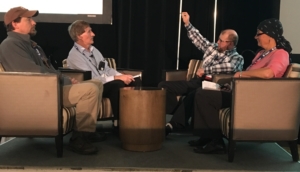With the compliance year of 2024 approaching, pork producers in Canada are looking at options for group housing for their sows.
Three of those options were presented at the Saskatchewan Pork Industry Symposium. Dr. Jennifer Brown, the moderator of the session and a research scientist at the Prairie Swine Centre, said sow housing used to be straightforward.
“The sow’s there, you’re feeding her, you’re checking her, and you’re breeding her. But with group housing, there are a huge number of options. It is mindboggling. Which way do you go? The ESF or which feeder system and how does it fit into a retrofit? It is really complex.”
 Tom Kennelly of Perkin Farms Inc. has a shoulder stall system with trickle feeding. The system was installed seven or eight years ago when renovations were needed to the operation’s barns.
Tom Kennelly of Perkin Farms Inc. has a shoulder stall system with trickle feeding. The system was installed seven or eight years ago when renovations were needed to the operation’s barns.
There are 10, 12 or 16 sows per stall. He said there are advantages and disadvantages to the system. On the positive side, he said sows are easy to move and the barns are much quieter.
He said it is imperative that the operation has good staff. If you don’t, it is a huge disadvantage.
“Without good stockmanship, this system would not work.” He said sows settled into their groups within a day or two. He said any that fall behind are removed from the group.
Dr. Brown sees advantages in the system.
“It’s a competitive system, so you have to keep sows in smaller groups and when you form those groups you have to make sure they are pretty well matched for size and parity so they can all compete for that food.
“The idea with trickle feed is that you deliver feed roughly as fast as the slowest sow is going to eat, so some bully sow is not going to get any extra feed by pushing her out of the way.”
She likes the small number of sows per stall.
“They are static groups so they stay in that same pen in that same group until they are ready to go to farrowing.”
Some might say Ted Ratte of Sunhaven Farms spoils his sows. It’s an ESF system on straw and partially slatted. He showed slides of the sows snuggling into the straw.
The barn was built near the turn of the century and was for group housing from the get-go. There are 30 pens with one EFS station in each. Each pen holds approximately 60 sows. He said two-thirds of the barn is wheat straw on cement, with the other third slatted.
He said the straw system looks good and smells good, there is minimal sow aggression and no feed waste. Sows have 24-hour access to feed.
“When everything is working and looking good, you can go in and there’ll be 1,500 sows and it’s very nice and quiet. When it’s not working, you only have one feed station, so the sows start getting more aggressive.”
He said it was costly to get it started. There were stations, straw and software to be purchased. He said it takes extra labour to manage the system.
Sam Waldner of Matador Farming Company Ltd., opened the doors to a new 600-sow, farrow-to-finish barn in 2015. His farm has 11 Nedap ESF units.
“He has a pen for the gilt and a pen for older sows and a pen for medium-aged sows,” Dr. Brown said. “Each of those pens has five feeders, so they have five times 60 (maximum capacity) and over 20-square-feet per sow, with nice bedroom areas along the sides. “It is a very sound system that he has been working on for a long time.”
Dr. Brown said a lot of new builds are using the Nedap systems.
“There is one in Nebraska that a lot of people have visited. They are getting amazing production. I heard someone say it is 36 pigs per sow per year. So these systems can be very well fine-tuned and the consistency of body condition is very impressive.”
Dr. Brown was asked about the costs of various systems.
“It depends on your herd size and what you choose,” she said. “Competitive systems like shoulder stalls are a cheaper installation, but it also requires more pen walls because you have smaller groups. But it can often use the same feed delivery system that you would have for stalls so that is a saving and you aren’t buying those expensive ESF units.”
She said there are systems coming out of Quebec that are less expensive than the ESFs.
“They have a little bit more flexibility, so we have seen a lot of interest in those. A lot of producers in Quebec have installed them and are quite happy because you only need to have 15 or 20 sows per feeder and you are more flexible in the groups you can form. That’s very nice if you are doing a retrofit. With a regular ESF system, you want to get your 60 sows on that feeder, so you need a big pen space.”
By 2024, producers will have to have group housing to comply with the code of practices. Dr. Brown said the only way around it is to provide sows with greater freedom of movement and periodic exercise.
“My take-home message on that is by in large we expect to see pretty much all producers going into group housing by 2024. There is a time period to adjust to this, but the most important thing is to start planning now and get information on how to manage housing groups.” •
— By Cam Hutchinson




